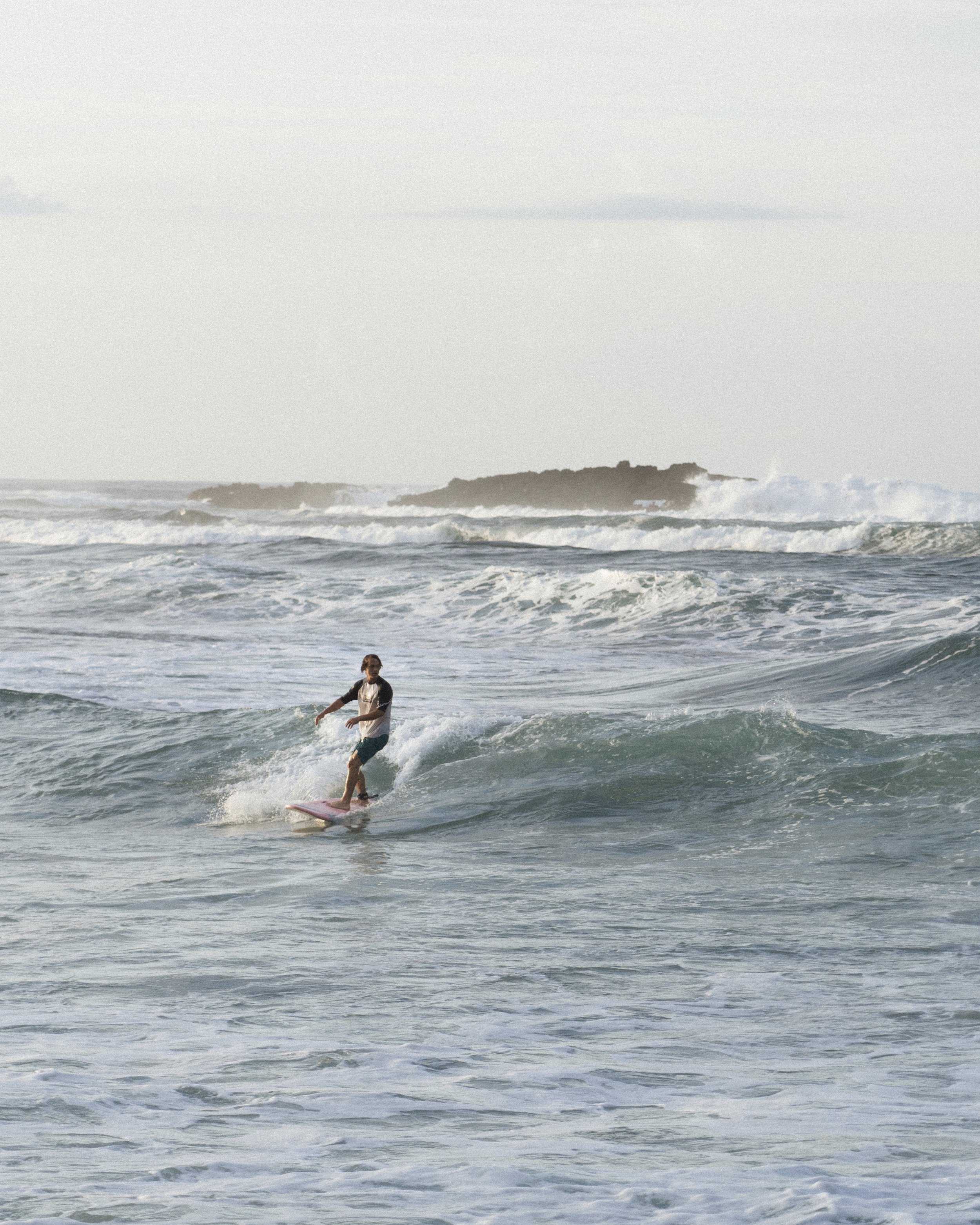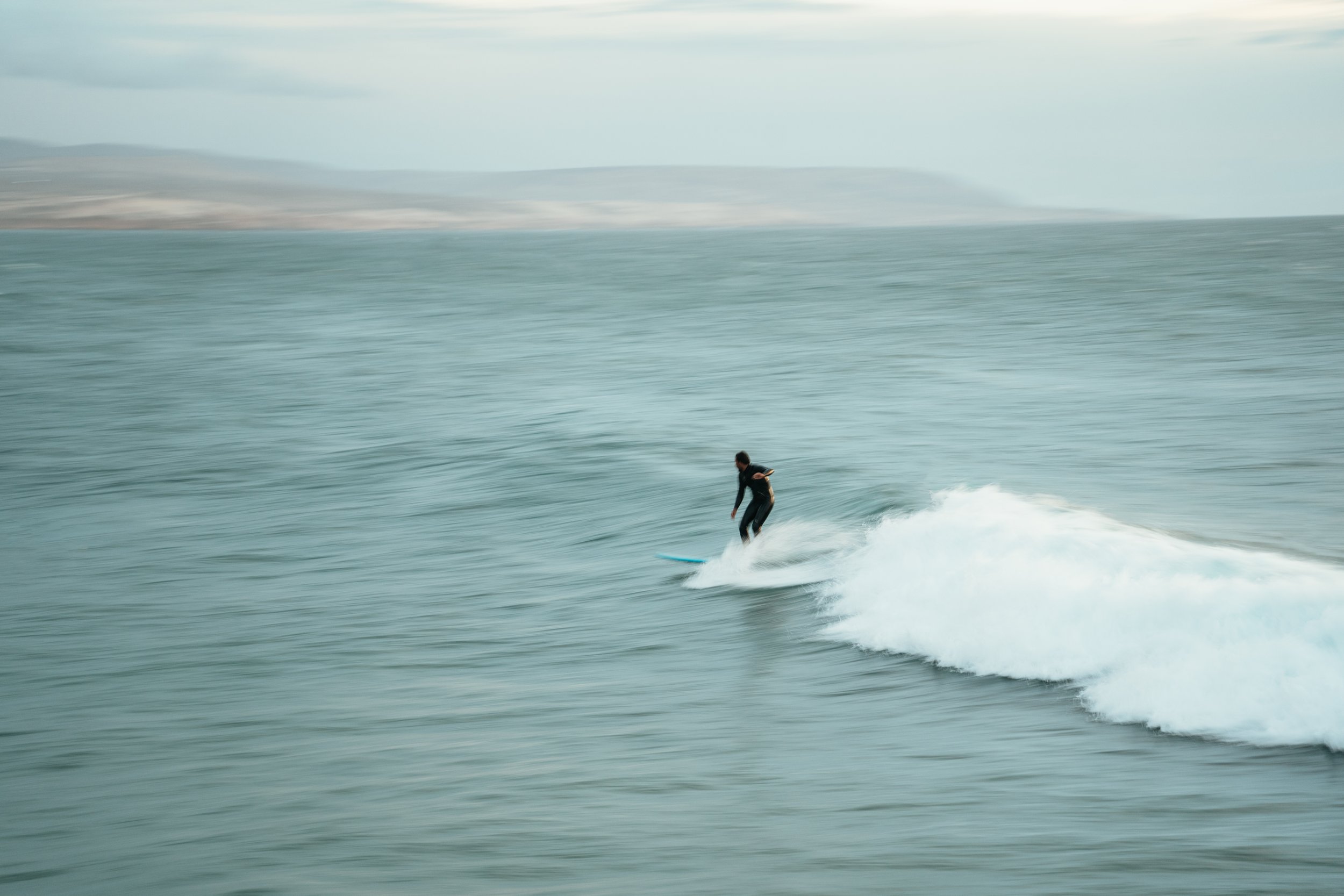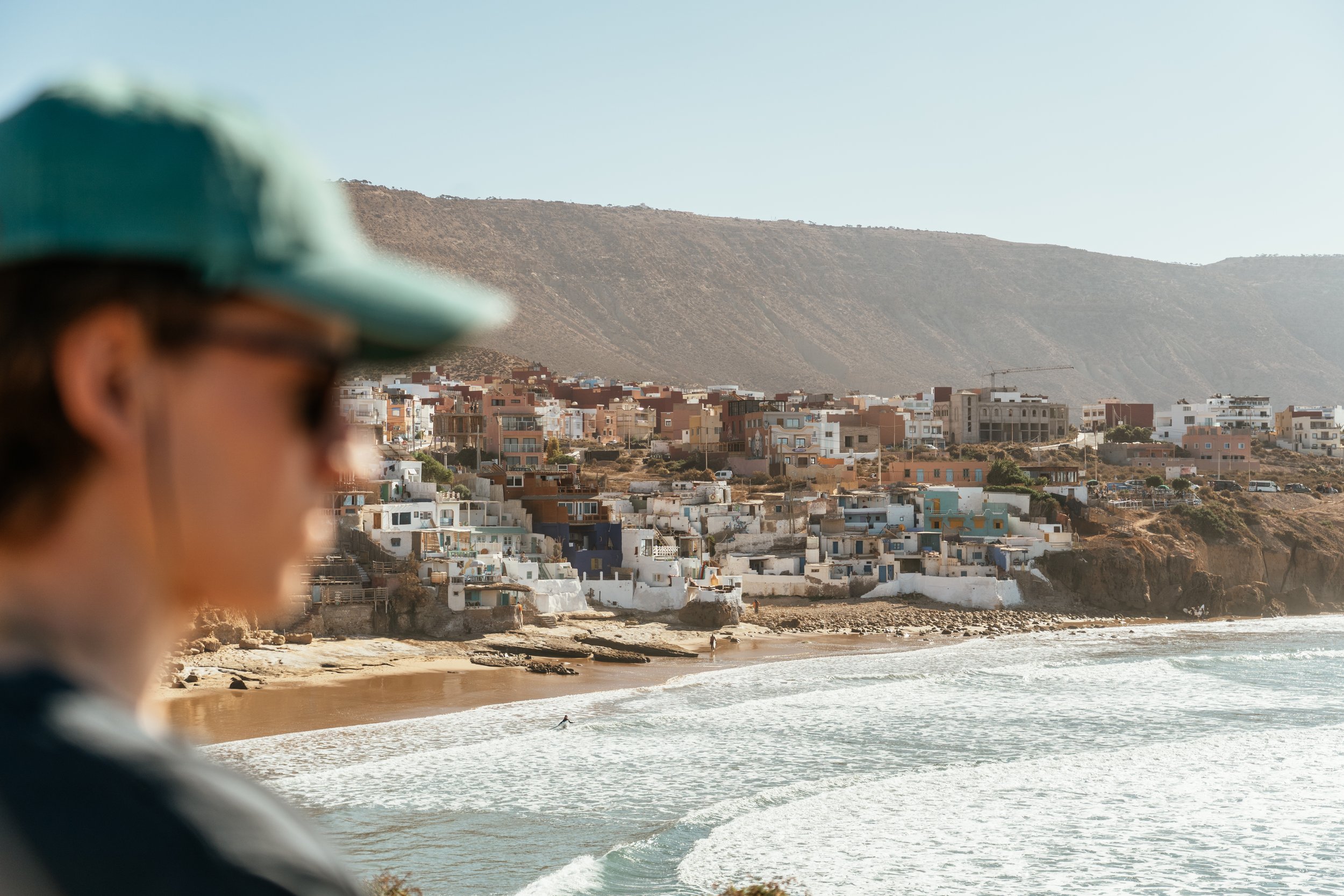How To Film Surfing
How to Film Surfing
Before we dive into the specifics of how to film surfing - are you looking to make a surf film?
If so, I wrote a super practical step-by-step guide to making your first adventure film. It’s how I create my award-winning surf films and hopefully will help you too! Check it out…
My background in surfing
Me just catching some mellow waves on a soft top in Puerto Rico
I’ve been surfing ever since I was a little kid. I grew up on an island off of Washington state but often only found myself surfing on family vacations to the sections of the coast that had waves. My surfing, and by extension my surf photography, really took off when I moved to Costa Rica in high school. Obviously being blessed by phenomenal waves and surfing with a community of other teenage boys that also are wanting to get after it in the ocean resulted in my surfing developing to a much higher level.
After living in Costa Rica I moved to Wales for the last two years of high school where I actually feel like my surfing blossomed into what it is today. It was there in Wales that my passion for video production started, I made my first surf “documentary” about two of my best friends and I surfing around Wales. In case you’re curious about the quality, it was all shot on a GoPro Hero 4 so definitely not too polished by any means but super fun to make and learn more about surf filmmaking.
After surfing in the U.K., I moved back to the United States where I would go on two or three large surf trips a year to film professional surfers in Costa Rica, California, or on the west coast of Canada. Surf photography has always been a passion of mine but only in the past few years has it become a bigger part of my filmmaking business and career.
So, over the course of eight years of taking my camera and wetsuit into the water to photograph and film surfers as a surf photographer and surf cinematographer, I figured I would write a little article to help provide some information for those hoping to get more into photographing and filming surfing.
Surf photography can often be broken down into two main styles…
in the water and on the beach
Surf Photography - On The Beach
Have a great telephoto lens (200mm+ is ideal)
When photographing surfers it’s important to make sure you have a lens that can create an intimate photo even while you’re far away. When you’re on the beach taking pictures or working on a larger video production set with your camera on land, there’s quite a distance between you and the surfer you’re photographing. Similar to wildlife photography, you just need a long lens if you’re wanting to capture the action.
Here are the best telephoto lenses for surf photography…
Get Elevated
I highly recommend that if you’re on land you’re filming from a cliff or some elevated section to position yourself above the waves. If you film directly on the shoreline the incoming waves may block the waves behind it so you need to be able to photograph above the incoming wave to capture the surfers.
Remember that your job as a surf photographer is to create a good image. You obviously want to capture the action and beauty of surfing and in order to do that you have to get above the incoming waves so you get the full scale of the wave that the surfer is riding.
Stay Stable
Have a tripod with a fluid head to follow your surfer on the wave with one fluid motion. This is arguably one of the most important rules of surf cinematography that is often overlooked by beginners. Being able to track a surfer on the wave takes a lot of panning movements from the shore and when your tripod isn’t stable it can ruin the whole day. It’s a bummer. Get a good tripod, you won’t regret it.
Create Depth
Bring a foreground element into your shot (a person, a rock, a palm tree, a house, etc.)
To create a great image you need depth. Providing a foreground element to your photos or videos is just one way to do that. Thankfully if you’re on the beach there’s often some way you can create that effect for your surf films. A few of the most popular ways are through the use of people, trees, houses or other obstacles that periodically pass through your video. If you have a surfer on the wave riding from left to right you can follow their movements when you pan the camera, ideally whizzing by a tree, a person standing on the beach, or a house in the process. Doing this gives people a sense of where you are and what you’re doing.
Aerial Cinematography / Drone Videography
To create high quality surf films, adding a drone into the edit will really add to the production value. Be aware of what flying a drone means for other surfers in the water and where you’re flying it - I almost never fly a drone in a crowded lineup, especially at a break that may be not totally public and you risk yourself exposing a secret spot.
Although I’m a part 107 commercially certified drone pilot, I think drones are super duper obnoxious and can definitely burn some bridges with local surfers depending on where / when you fly them so just be thoughtful of other’s experience in the water.
If you are creating a surf lifestyle commercial or charging people for a surf film it’s important to have insurance and your commercial license. In the United States that is the part 107sUAS certification and is a super helpful drone license to have. I received my part 107 commercial drone license a few years ago and have seen many clients be able to utilize that certification bringing more business and opportunities my way, so if you’re on a drone I would recommend studying and getting your license for it so you can start to charge people and companies. More on Part 107 Drone License Here
Get Cozy
Bring snacks, headphones, music, a chair, and lots of layers. You’re gonna be chilling for a while so prepare for that.
This tip is more about comfort and less about executing the perfect photograph but being cold and hungry on the beach while your friends or athletes are out surfing is not always the greatest feeling. I’ve directed and produced both low budget and higher budget adventure films and the biggest thing I’ve discovered that comes with highly professional video productions is the level of preparation. So even if you’re on a small budget or no budget at all you can still bring that level of comfort to your video productions to ensure that everybody from the director of photography, the part 107 drone operator, commercial photographer, the gaffer, and even the production assistant are feeling good about what you’re doing out there.
Surf Photography - In The Water
Filming surfing this way is a lot more immersive and can be a bigger financial and physical investment but produces some of the best photos and videos out there.
Protect Your Camera in the Water
Purchase a water housing (a dome is ideal since it allows for a wide angle perspective)
There’s all types of water housings out there so I would recommend doing your own research online to see which are the best ones for your specific camera model. Some camera water housings are made for diving which can be a little more expensive and elaborate. Others are glorified Ziploc bags to protect your camera from getting wet. I think there’s a sweet spot right in the middle that will allow you to take your camera into the ocean safely and responsibly while still preserving the image quality.
This is my complete camera set up when I go to the water:
Prepare to move
Wear flippers and, depending on your shot list, goggles!
If you think about what you are trying to film, surfers have boards and boards move fast in the water. If you’re trying to swim one-handed (because one hand is going to be on your camera) you will struggle to get out to the lineup. Bringing a pair of slippers with you is almost as important as having your camera. Make a checklist of what to bring and don’t forget anything.
Similarly, if you’re going to be shooting underwater at any point during the day having a pair of goggles to see what you’re filming is also important. Surf photographers in tropical waters will often bring goggles because the water is so clear they can get interesting in creative shots of the wave, the surfers on their boards, or even some wildlife under the surface if they’re lucky. As a surf photographer who tends to primarily shoos in murkier colder water I will sometimes leave the goggles in the car since I’m not able to get crystal blue water shots under the surface. Still, it’s better to have them and not need them then need them and not have them so always bring them along.
Here’s a photo of me about to get into very cold water and not looking excited about it
Bundle Up
Wetsuits are often crucial - you’re not as active as surfers and just sitting in the water so unless you’re chilling in some warm weather tropical water, bring a wetsuit. It’s a bummer when you have to leave early to get warm right when the waves get pumping.
Collaborate with the surfers
Work with specific surfers and trust them to get close to you.
Collaboration is really important when creating a surf film. Communicating what shots you would like to get and what you need from the surfers will make a difference between a good and great film. If you go out in the water to photograph a stranger surfing you may find yourself in a risky situation. By working alongside people you know, you start to have a little bit more control over what happens in front of the camera. Some of the greatest shots from the water are once where you allow your subject to get close to the camera which will feel scary at first since you have surf fins coming with any inches of your face but you will slowly understand where you need to be in the water and begin to trust your surfers to get themselves in the right position for your shot.
Shoot at Golden Hour
Plan your session for an hour before sunset or after sunrise - filming in the water right at sunset is often rough for a lot of cameras (shoutout to the Sony a7siii for practically being able to see in the dark and not have this issue as much). The water gets a little to dark to film at “blue hour” or after the sun goes down, especially in slow motion where your shutter speed has to be 2x your frame rate so likely 1/125 or 1/250. If you want those post sunset shots, you may have to get out of the water and film on a tripod to keep things steady and lower your shutter speed.
Film in slow motion
If you’re filming in the water, things can get pretty hectic from a stabilization standpoint. Filming in slow motion creates a sort of otherworldly image in which you can start to appreciate the intricacies of the wave and the person riding it. Waves are fast in and surfers can fly by so if you’re not filming in slow motion you and your audience may miss the moment. There are exceptions to this rule but most of the time in the water my camera is set to 60 or 120 frames per second allowing me to slow the clips down by at least 40% and getting rid of the shaky movements.
Keeping Things Steady
A heavier camera or a camera will internal stabilization will also help keep things steady
Having a stable shot is surprisingly difficult when filming in the water. You’re often treading water with your flippers, there are waves crashing over you and your camera, you’re trying to get in the right position with the surfers, and you may get scared with a surf fin flying by your face. All these factors contribute to the camera shaking and your footage not becoming usable.
The reason I shoot on a Sony A7siii with the 24-105 mm lens is not because of the zoom focal length but because of it’s great optical stabilization. This way both my camera and my lens have stabilization built-in which helps keep things level and stable in the water. I’ve played around with a lot of different lens and body combos but for filming surfing in the water and most video production jobs in the ocean I found this combination to be my favorite.
Tell the Full Story
Capture all elements of the surfing process, not just a surfer on a wave!
For a lot of us that are drawn to the surf world don’t just love it because of the waves. We love the whole process. When you start to compare the surf community and other traditional sport communities such as basketball, football, or baseball you may notice that the surf community is a bit more spiritual about their sport. So, capitalize on that!
Film your surfer putting on the wetsuit, stretching at the waterfront, paddling out, waiting for waves, details of water droplets of the wave, etc. Give your audience a chance to not just see what it looks like out there but begin to understand what it may feel like. Try to capture every sense on video. Is there a way you can effectively communicate how the salt of the ocean my taste through the visuals you capture? Play around! Don’t just get banger surf photos, tell a story!
Bonus Tips
Lick the water housing - there’s different ways to keep the housing clean but I found that licking it is the easiest and most common for me. It sounds crazy but it works…
Have a warm change of clothes and business cards ready for when you get out of the water!
Almost every time I shoot in the water, people ask for my Instagram or website to see my work after filming in the water (especially if you’re just getting shots of everybody)
Be respectful! Don’t ruin people’s sessions just to get a good shot of them. Working with people you already know is a good way to prevent this.
Final bonus tip - if you’re not by the ocean but still need to practice some underwater cinematography or underwater photography, there’s ways to make it happen! Here’s a video I made of the time I went to film in Rocky Mountain National Park to get some cold water immersion with my water housing before a surf photography trip…
Contact Me!
Roo is a commercial/documentary filmmaker and photographer based in Boulder, Colorado but travels all around the world for his filmmaking career. He has produced films for Outside Magazine in Ireland, camera operated for Netflix in the Rocky Mountain West, photographed among indigenous communities in Peru and Ecuador, directed videos with professional climbers in Mexico and has received notable recognition in his hometown of Orcas Island in Washington State for his work telling uplifting stories in the outdoor space.
If you have questions or want to talk more about my life as a Boulder cinematographer, adventure, surf photography, photography, adventure filmmaking please reach out! I always love connecting with new people and talking through how I can help them achieve their dreams in telling stories of impact.













